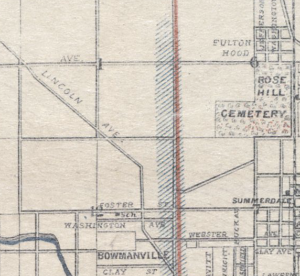Although there is significant overlap between historical Summerdale and the area now called Bowmanville, historical Bowmanville is one mile west of the Summerdale neighborhood, and development there pre-dates Summerdale by about 30 years. Bowmanville was, historically speaking, founded in the 1850s as a small village centered near the intersection of Foster and Lincoln.

From Alfred Theodore Andreas, History of Cook County: From the Earliest Period to the Present Time (1884):
This village lies in the eastern part of the [Jefferson] township. The original plat comprised the east half of the southeast quarter and the north half of the northwest quarter of Section 12. Shackford’s subdivision comprises the southwest quarter of the southeast quarter of Section 12 and Jackson’s subdivision comprises the southwest quarter of the southeast quarter. It is one mile west of Summerdale, a station on the Milwaukee Division of the Chicago & North Western Railroad, six and six tenth miles from Chicago. It is partly located on the southwest ends of the elevated land extending south from Milwaukee and known as Milwaukee Ridge. On this ridge is found excellent well water by digging to a depth of from twelve to twenty feet. In early days the hill immediately north of and adjoining Bowmanville received the name of Roe’s hill, from Hiram Roe who lived very near the present location of J. A. Budlong’s residence and kept whiskey for the accommodation of the settlers on their way to and from Chicago. From this form of the words “Roe’s hill,” the present Rosehill was derived. The name Bowmanville was derived from a Mr Bowman who having in 1850 purchased a considerable tract of land, sold it out in smaller tracts of from two to ten acres and left the country. It was afterward discovered that his title was not good, and those who had purchased of him, were obliged to pay for the land a second time.
The first store in this place was built by Christian Brudy, in 1868, who came from Kentucky in 1865, built a saloon in Bowmanville in 1867, and added the store in 1868. The store building is twenty two-by thirty-two feet in size, the saloon part forty two by fifty two. The store was rented to “Al.” Jackson who in a short time sold his stock of merchandise to John Berg. In 1872 Mr Berg sold out to Baptiste Putnam and started a store of his own, the second store in the place. In 1874 Mr Brudy took the store into his own hands and has since conducted the business. The first house built in the town, was a small frame one, by John Fountain, in 1854. The first saloon started was by Leonard Mehr in 1856. Mr Mehr died in 1860. Another saloon was started by Thomas Freestone in his hotel, but the saloon was abandoned in 1857. A brewery was started by Freestone and John Rohrbach. When Mr Vollmer came to Bowmanville he bought it, and in 1873 built a brick building for ice and a frame one for malt, the whole costing $8,000. At the present time there are eight saloons in the place. The original survey and platting of the town was quite faulty. On the 14th of August, 1876, the village engineer of Jefferson reported that he had resurveyed the subdivision of Bowmanville and set stakes at the centers of streets in that subdivision, and that many fences and houses were standing on the streets.
Budlong’s Pickle Factory was started in 1869. It is owned by Lyman A. and J. A. Budlong. It is a two story frame building with wagon sheds attached and sheds for salting the pickles. It has been enlarged from time to time as the increase of the business required. The entire cost for steam boiler and pumps has been about $5,500, and for tubs and salting vats about $10,500. A general assortment of pickles is made including cucumbers, beets, onions, cauliflowers, tomatoes, etc. The capacity of the factory is thirty thousand barrels. Bowmanville now contains about five hundred inhabitants.